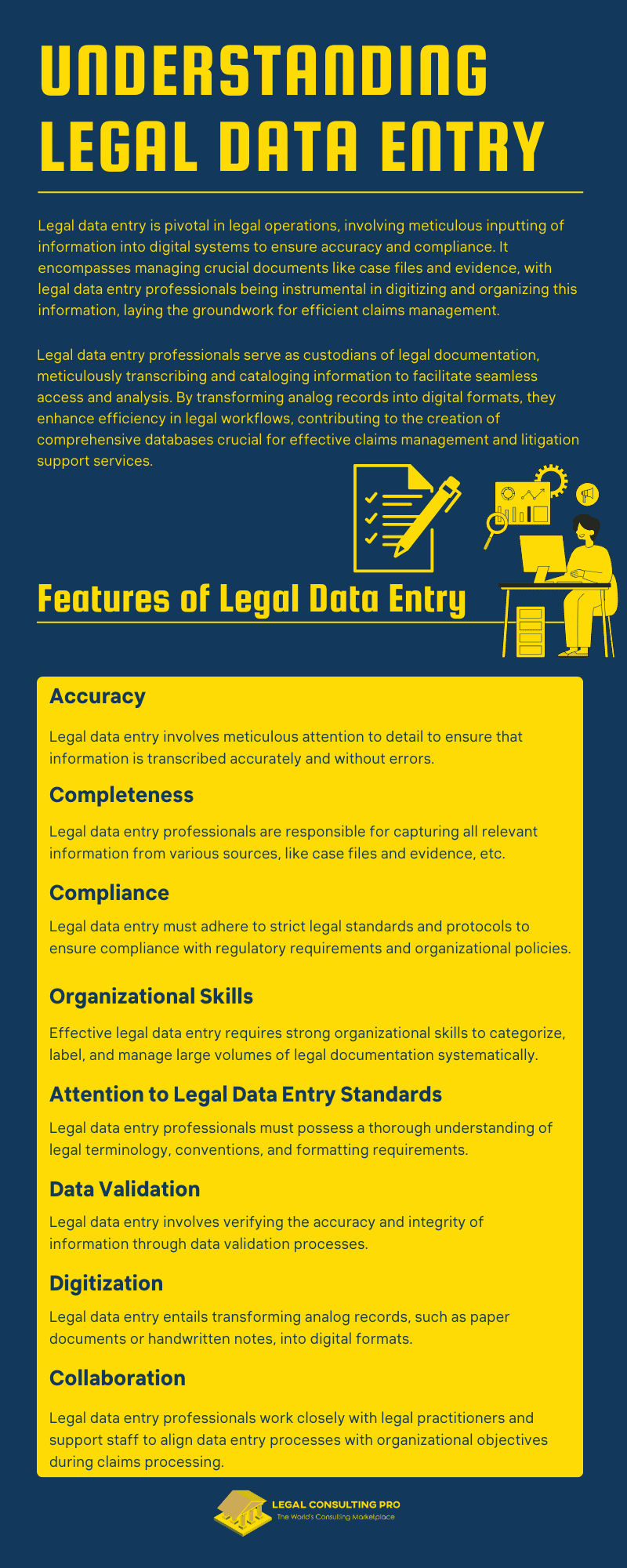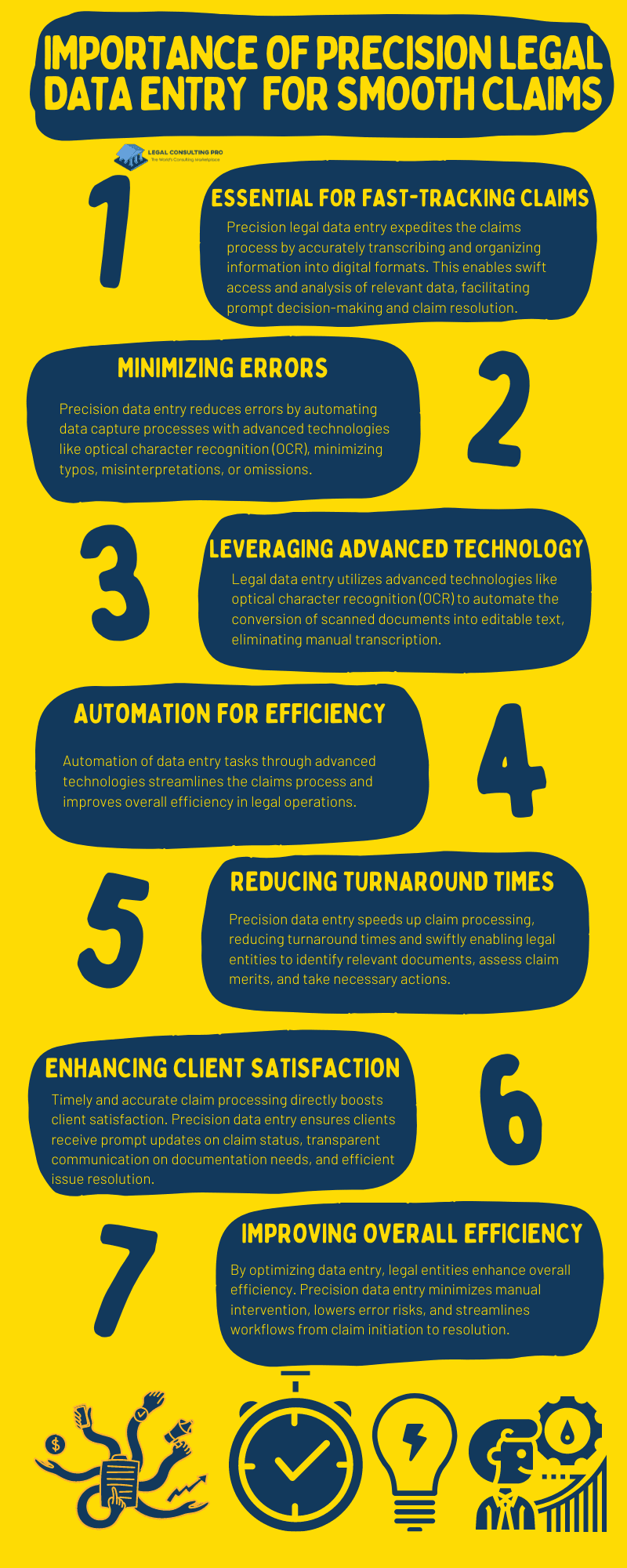Introduction
In the fast-paced world of legal data entry proceedings, precision and accuracy are paramount, especially when it comes to managing claims. With the increasing complexity and volume of legal data, efficient data entry processes are crucial for streamlining the claims process. This article explores the significance of precision legal data entry in fast-tracking claims and minimizing errors, highlighting the role of litigation support services in optimizing efficiency and accuracy.
Understanding Legal Data Entry
Legal data entry is a foundational process within legal operations, encompassing the meticulous inputting of information into digital systems or databases to ensure accuracy, completeness, and compliance with legal data entry standards. This multifaceted task involves handling a diverse array of documents critical to legal proceedings, including case files, evidence, witness statements, and correspondence. Legal data entry professionals are tasked with the responsibility of digitizing, organizing, and managing vast amounts of legal information, serving as the backbone of effective claims management processes.
In essence, legal data entry professionals act as custodians of legal documentation, meticulously transcribing and cataloging information to facilitate seamless access, retrieval, and analysis. They play a pivotal role in transforming analog records into digital formats, enabling greater efficiency and accessibility in legal data entry workflows. By ensuring that information is accurately captured and stored within digital repositories, legal data entry professionals contribute to the creation of comprehensive databases essential for effective claims management and litigation support services.
Moreover, legal data entry extends beyond mere transcription; it involves data validation, quality assurance, and adherence to stringent legal standards and protocols. Legal data entry professionals must possess a keen attention to detail and a thorough understanding of legal data entry terminology and conventions to accurately interpret and input information. They work closely with legal practitioners and support staff to verify the accuracy and integrity of data, ensuring that it aligns with regulatory requirements and organizational policies.
Features of Legal Data Entry:
- Accuracy: Legal data entry involves meticulous attention to detail to ensure that information is transcribed accurately and without errors. Precision is paramount in maintaining the integrity of legal documentation and supporting effective claims management.
- Completeness: Legal data entry professionals are responsible for capturing all relevant information from various sources, including case files, evidence, and correspondence. Completeness ensures that the digital records provide a comprehensive representation of the legal proceedings.
- Compliance: Legal data entry must adhere to strict legal standards and protocols to ensure compliance with regulatory requirements and organizational policies. This includes safeguarding sensitive information, maintaining confidentiality, and adhering to data protection laws.
- Organizational Skills: Effective legal data entry requires strong organizational skills to categorize, label, and manage large volumes of legal documentation systematically. Organized data structures facilitate efficient retrieval and analysis of information during the claims process.
- Attention to Legal Data Entry Standards: Data entry professionals must possess a thorough understanding of legal terminology, conventions, and formatting requirements. Adherence to legal data entry standards ensures that transcribed information accurately reflects the nuances and complexities of legal proceedings.
- Data Validation: Legal data entry involves verifying the accuracy and integrity of information through data validation processes. This may include cross-referencing data with multiple sources, conducting quality assurance checks, and resolving discrepancies to maintain data accuracy.
- Digitization: Legal data entry entails transforming analog records, such as paper documents or handwritten notes, into digital formats. Digitization facilitates efficient storage, retrieval, and sharing of legal information across digital platforms and systems.
- Collaboration: Legal data entry professionals collaborate closely with legal practitioners, support staff, and other stakeholders to ensure that data entry processes align with organizational objectives and support the needs of legal professionals during the claims process.
By incorporating these features into their data entry processes, data entry can establish robust frameworks for managing legal information effectively, supporting claims management, and facilitating successful outcomes in legal proceedings.

Challenges in Claims Processing
The claims process within the legal data entry domain is a multifaceted endeavor fraught with challenges, ranging from data inaccuracies to regulatory compliance issues. In an environment characterized by tight deadlines and complex legal requirements, efficient management of claims data is paramount for ensuring smooth proceedings and favorable outcomes. However, manual data entry methods often fall short of meeting the demands of the claims process, leaving legal entities vulnerable to errors, delays, and increased costs.
- Data Inaccuracies: The claims process faces the risk of inaccuracies due to human error, incomplete information, or outdated records. These inaccuracies can lead to misinterpretations of data, resulting in erroneous conclusions and decisions during legal data entry proceedings.
- Time Constraints: Legal entities often operate under tight deadlines, requiring expedited processing of claims to meet client expectations or comply with court-mandated timelines. Manual data entry methods may not be conducive to swift processing, leading to delays and potential consequences such as missed deadlines or opportunities.
- Regulatory Compliance Issues: Legal data entry claims must adhere to various regulatory requirements and compliance standards, adding complexity to the claims process. Manual data entry methods may inadvertently overlook regulatory nuances or fail to capture essential information, exposing the organization to compliance risks and potential legal liabilities.
- Susceptibility to Errors: Manual data entry methods, including typing or copying information from physical documents to digital formats, are prone to errors such as typos, misinterpretations, or omissions. These errors can undermine the accuracy and reliability of claims data, potentially leading to disputes, rework, or legal data entry challenges.
- Delays and Disputes: Errors in data entry can result in delays in claims processing or disputes between parties involved in legal proceedings. These delays can prolong the resolution of claims, escalate costs, and strain relationships between legal data entry and their clients or counterparties.
- Increased Costs: Inaccuracies or delays resulting from manual data entry errors can incur additional costs for legal entities, including resources spent on rectifying errors, addressing disputes, or resolving compliance issues. These increased costs can erode profitability and hinder organizational efficiency.
- Volume and Complexity of Data Entry: The sheer volume and complexity of legal data, including case files, evidence, and documentation, pose significant challenges to manual data entry methods. Handling large datasets or intricate information structures manually can be time-consuming and error-prone, necessitating more efficient and precise data entry solutions to maintain consistency and integrity throughout the claims process.
Importance of Precision Legal Data Entry
- Essential for Fast-Tracking Claims: Precision legal data entry is indispensable for expediting the claims process. By accurately transcribing and organizing information into digital formats, legal entities can swiftly access and analyze relevant data, facilitating prompt decision-making and resolution of claims. Precision data entry streamlines workflows, minimizes administrative bottlenecks and accelerates the overall claims processing timeline.
- Minimizing Errors: Precision data entry significantly reduces the risk of errors inherent in manual data entry methods. By leveraging advanced technologies such as optical character recognition (OCR), legal data entry can automate data capture processes, minimizing the likelihood of typos, misinterpretations, or omissions. This enhanced accuracy ensures that claims data is reliable and error-free, mitigating the potential for disputes, rework, or legal challenges.
- Leveraging Advanced Technologies: Legal data entry can harness a range of advanced technologies to enhance precision in data entry processes. Optical character recognition (OCR) enables the automated conversion of scanned documents or images into editable text, eliminating the need for manual transcription. Data extraction algorithms extract relevant information from structured and unstructured data sources, facilitating efficient data entry and validation. Machine learning algorithms can further enhance accuracy by continuously improving data interpretation and classification capabilities over time.
- Automation for Efficiency: Automation of data entry tasks through advanced technologies streamlines the claims process and improves overall efficiency in legal operations. By automating repetitive and time-consuming tasks, legal entities can reallocate resources to more strategic activities, such as case analysis, client consultation, or negotiation. This increased efficiency enables litigation support services providers to handle a higher volume of claims while maintaining quality and accuracy standards.
- Reducing Turnaround Times: Precision data entry enables expedited processing of claims, leading to reduced turnaround times and faster resolution of legal data entry matters. By accurately capturing and categorizing information, legal entities can swiftly identify relevant documents, assess the merits of claims, and take appropriate actions. This agility in claims processing enhances client satisfaction, strengthens client relationships, and establishes the organization as a trusted partner in legal matters.
- Enhancing Client Satisfaction: Timely and accurate processing of claims directly contributes to enhanced client satisfaction. Precision data entry ensures that clients receive prompt updates on the status of their claims, transparent communication regarding documentation requirements, and efficient resolution of issues. This proactive approach to claims management fosters trust, loyalty, and positive client experiences, ultimately driving client retention and referrals.
- Improving Overall Efficiency: By optimizing data entry processes, legal entities can improve overall efficiency in legal data entry operations. Precision data entry minimizes manual intervention, reduces the risk of errors, and streamlines workflows from claim initiation to resolution. This improved efficiency translates into cost savings, resource optimization, and better utilization of staff expertise, positioning the organization for long-term success in the legal domain.

Leveraging Litigation Support Services
- Specialized Expertise: Litigation support services offer access to professionals with specialized expertise in legal data entry, document management, e-discovery, and case preparation. These experts possess in-depth knowledge of legal processes, regulations, and industry best practices, enabling them to provide valuable insights and guidance to legal entities.
- Technology Solutions: Litigation support services leverage advanced technology solutions to streamline legal data entry processes and enhance efficiency. This may include document management systems, e-discovery platforms, data analytics tools, and workflow automation software. By implementing tailored technology solutions, legal entities can optimize their claims process and improve overall productivity.
- Resource Allocation: Litigation support services help legal data entry allocate resources effectively by providing on-demand access to skilled professionals and technology resources. Rather than investing in costly infrastructure or hiring additional staff, legal entities can outsource specific tasks or projects to litigation support services providers, allowing them to focus on core legal activities.
- Document Management: Litigation support services assist legal entities in organizing, categorizing, and managing vast amounts of legal data entry documentation related to claims. This includes digitizing paper documents, establishing document retention policies, and implementing document review workflows. Effective document management ensures that relevant information is readily accessible, facilitating efficient claims processing.
- E-Discovery: E-discovery is a critical component of the claims process, involving the identification, preservation, and analysis of electronic evidence. Litigation support services employ e-discovery experts and technology platforms to streamline the e-discovery process, ensuring that relevant electronic data is identified, collected, and analyzed in a defensible manner.
- Data Analysis: Litigation support services utilize data analytics tools and techniques to analyze large volumes of data and extract actionable insights. By performing data analysis, legal entities can identify patterns, trends, and anomalies in claims data, enabling informed decision-making and strategy development.
- Case Preparation: Litigation support services assist legal entities in preparing for litigation by organizing evidence, preparing exhibits, and conducting legal data entry research. These services ensure that litigation support services providers have access to the necessary resources and support to build a strong case and effectively represent their clients in court.
- Expedited Claims Process: By leveraging litigation support services, legal entities can expedite the claims process and reduce turnaround times. These services streamline data entry, document management, and e-discovery processes, enabling litigation support services providers to efficiently handle claims and resolve disputes promptly.
- Accuracy and Compliance: Litigation support services uphold strict standards of accuracy and compliance with legal data entry requirements. By employing trained professionals and implementing robust quality control measures, these services ensure that claims data is accurate, reliable, and compliant with regulatory standards.
Overall, litigation support services play a crucial role in optimizing legal data entry processes and streamlining the claims process. By providing specialized expertise, technology solutions, and resources, these services enable legal entities to manage complex litigation and claims effectively, ensuring accuracy, efficiency, and compliance throughout the legal proceedings.
Best Practices for Precision Legal Data Entry
Maximizing the benefits of precision legal data entry is crucial for legal entities seeking to enhance efficiency, accuracy, and compliance in their claims processes. By adopting best practices, organizations can minimize errors, mitigate risks, and optimize overall outcomes. This section outlines key best practices that legal entities should consider implementing to maximize the effectiveness of precision legal data entry.
- Standardized Data Entry Procedures: Establishing standardized data entry procedures ensures consistency and uniformity across all data entry tasks. Legal entities should develop clear guidelines outlining the steps to be followed, data formats to be used, and quality standards to be upheld during data entry processes. Standardization minimizes variations in data entry practices, reduces the risk of errors, and enhances overall efficiency in managing claims data.
- Utilization of Automation Technologies: Leveraging automation technologies such as optical character recognition (OCR), data extraction algorithms, and workflow automation software can streamline data entry processes and improve accuracy. Automation reduces manual intervention, eliminates repetitive tasks, and accelerates data entry workflows. By automating routine data entry tasks, legal data entry can free up valuable resources to focus on more strategic activities, ultimately enhancing productivity and efficiency.
- Regular Quality Checks: Conducting regular quality checks is essential for ensuring the accuracy and integrity of claims data. Legal entities should implement mechanisms to verify the accuracy of data entered, identify any discrepancies or errors, and take corrective action as needed. Quality checks may involve sample audits, data validation exercises, or cross-referencing data with external sources to ensure consistency and reliability. By proactively monitoring data quality, legal entities can detect and rectify issues before they escalate, thereby minimizing risks and maintaining compliance with legal data entry standards.
- Comprehensive Training for Data Entry Professionals: Providing comprehensive training and ongoing support to data entry professionals is critical for ensuring proficiency and adherence to best practices. Legal entities should invest in training programs that cover relevant topics such as data entry techniques, legal terminology, software usage, and quality assurance protocols. Additionally, ongoing coaching and feedback sessions can help reinforce learning and address any gaps in skills or knowledge. By equipping data entry professionals with the necessary tools and skills, legal entities can enhance accuracy, efficiency, and compliance in their claims processes.
By adhering to these best practices, legal entities can optimize the effectiveness of precision legal data entry and realize significant benefits in terms of efficiency, accuracy, and compliance. Implementing standardized procedures, leveraging automation technologies, conducting regular quality checks, and providing comprehensive training are essential steps toward enhancing claims processing outcomes and delivering superior service to clients.
Case Study: The Impact of Precision Data Entry on Claims Processing
A case study serves as a compelling narrative that demonstrates the tangible benefits of precision data entry on claims processing. By delving into a specific scenario where precision data entry techniques were employed, readers gain valuable insights into how efficiency, accuracy, and client satisfaction were enhanced. For instance, let’s consider a law firm handling a complex litigation case involving multiple parties and voluminous documentation.
In this scenario, the implementation of precision data entry techniques, such as leveraging automation technologies and conducting regular quality checks, significantly expedited the claims processing timeline. Documents were accurately transcribed, categorized, and stored in digital repositories, streamlining access and retrieval for legal professionals involved in the case. This improved efficiency not only reduced turnaround times for claims processing but also facilitated quicker decision-making and resolution of legal matters.
Moreover, the enhanced accuracy resulting from precision data entry minimized the risk of errors or discrepancies in claims data, thereby bolstering the credibility and reliability of the legal organization’s services. As a result, client satisfaction levels soared, as clients experienced prompt updates, transparent communication, and efficient handling of their claims.
Ultimately, the real-world impact of precision data entry in this case study underscores its transformative potential in optimizing claims processing outcomes, enhancing organizational efficiency, and delivering superior value to clients.
Conclusion
Precision legal data entry is pivotal for expediting claims processing and minimizing errors in the legal process. By leveraging advanced technologies and litigation support services, legal entities can streamline the claims process, enhance efficiency, and improve client outcomes. By adhering to best practices and prioritizing accuracy, data entry can confidently navigate the complexities of claims processing, ensuring seamless and successful outcomes for all stakeholders involved.
Through accurate transcription and organization of information, legal entities can significantly reduce processing times, facilitating quicker resolutions to claims and disputes, thus enhancing overall client satisfaction. Integration of advanced technologies and support services further amplifies the efficacy of precision data entry, enabling compliance with legal standards and regulations while optimizing workflows.
Embracing precision data entry practices and committing to standardized procedures and quality checks empowers legal entities to uphold high standards of accuracy and professionalism, ultimately fostering trust and confidence among stakeholders and strengthening the organization’s reputation in the domain.
Read Similar Blogs:
Legal Data Entry: Stock Your Shelves, Not Errors: Keeping Track of Assets with Streamlined Inventory













































